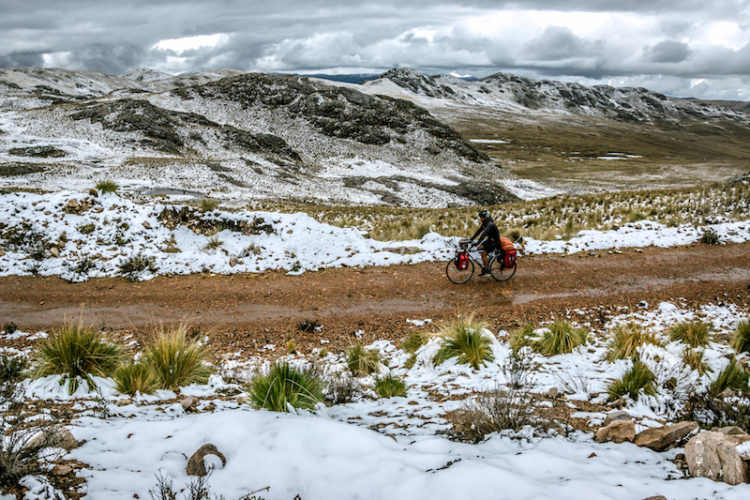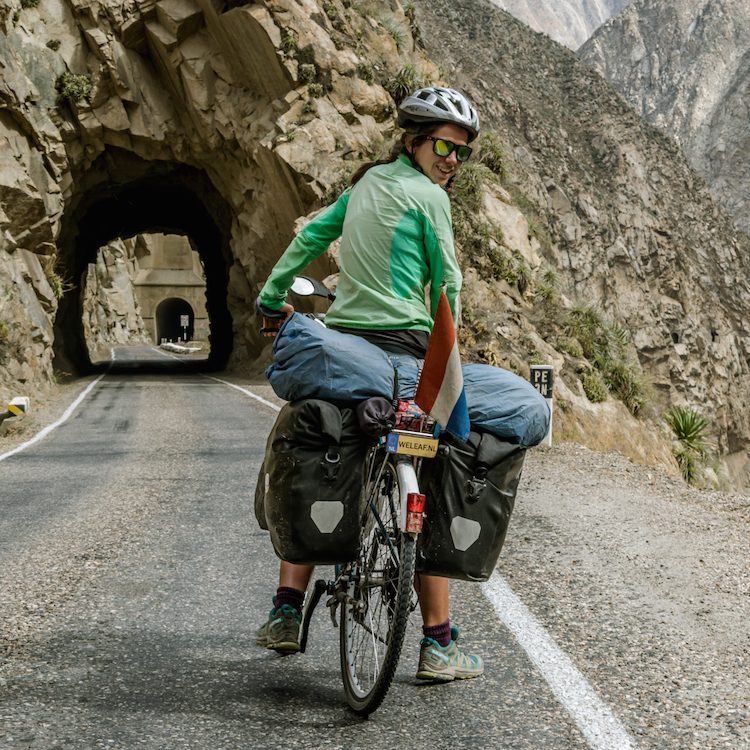
Cycling in Peru

Our private road
September 18, 2018
Everything changes
September 23, 2018
Cycling in Peru
Cycling in Peru is beautiful and heavy at the same time. The routes go from top to bottom with climbing and descents of sixty kilometers. Sometimes you are just climbing all days and you are only forty kilometers further at the end of the day. Many routes cross passes above 4,000 meters where it is sometimes freezing cold, while you cycle through the banana plantations and palm trees deep in the valley. Because Peru is so elongated, in combination with the many climbs, it seems sometimes endless to get through Peru. It is therefore not surprising that many cyclists travel part of Peru by bus because they don't have enough with the 3 month visa. These are our tips for cycling in Peru.


Our route
In the map below you can find our route in Peru. We have added a short description with the amount of traffic, the type of road and the number of villages that you encounter.
Bolivia border - Cuzco : a lot of traffic, asphalt in good condition, many villages, relatively little climbing.
Cusco - Abancay : a lot of traffic, asphalt in good condition, many villages on the way, lots of biting flies under 2,800 meters, long and heavy climb.
Abancay - Andahuaylas : little traffic, asphalt in good condition and a part unpaved on old route, many villages, many biting flies under 2.800 meters, long and heavy climb.
Andahuaylas - Ayacucho : moderate traffic, asphalt well, many villages up to Ocros, a lot of biting flies under 2,800 meters, long and heavy climb.
Ayacucho - Huancayo : lots of traffic, bad asphalt, many villages, countless biting flies, long climb
Huancayo - Huanuco : a lot of traffic, good asphalt, many villages, relatively little climbing
Huanuco - Huaraz : little traffic (except last part to Huaraz ), first part dirt road, many villages, beautiful route
Huaraz - Caraz : a lot of traffic, asphalt
Caraz - Chuquiscara : canyon del Pato, hardly any traffic, asphalt
Chuquiscara - Huamachuco : hardly any traffic, many parts dirt roads, very steep climbing, many villages
Huamachuco - Cajamarca : little traffic, tough climbing, asphalt, few biting flies
Cajamarca - Bambamarca: a lot of traffic (mines), partly dirt road, long climb
Bambamarca - Cutervo : little traffic, mostly asphalt, a lot of wind
Cutervo - Chiple : low traffic, steep climbing, unpaved
Chiple - Olmos : moderate traffic, asphalt, one steep climb
Olmos - Piura : little to moderate traffic closer to Piura, asphalt
Piura - Mancora : moderate traffic, partly unpaved, windy, desert
Mancora - Zorritos : moderate traffic, asphalt, lots of wind
Zorritos - border : a lot of traffic, asphalt, a lot of wind.
Sleeping
In almost every village you can find hostals, hotels or hospedajes. The cheapest rooms you can find from 10 soles (€ 2.50), and for 15 soles you already have a room with private bathroom. Usually you get a towel and toilet paper. Most places have internet, although the quality is often poor.
Camping is easy and safe. With iOverlander you quickly find a lot of good places, but you will find many places yourself as well. Above 3,000 meters it is a bit cooler at night and above 4,000 meters it can be freezing cold. Below 2,500 meters you can, on the other hand, suffer a lot from small biting flies that make the camping much less pleasant.
The warmshower network in Peru is not very big. In the big cities there are a few warmshowers, but in the rest of the country it is very limited. In Juliaca and Abancay there is a casa de ciclistas. In the small villages you can always knock the door of the puesto de salud, the municipalidad or the police. Often they have a small room available to lay down your sleeping mat.
Climate
The winter months, June to September, are normally the dry months in Peru, but in the mountains it is always unpredictable. From January to March it will rain a lot in Peru, which will make the dirt roads a lot more difficult.


Drink and eat
It is almost impossible to cook for the price of an almuerzo (lunch) or cena (dinner). You usually get a plate of soup, main course and a drink for 5 soles (€ 1.30). As a main course there is a choice between three or four dishes. For the vegetarians the choice is limited, but arroz a la cubana and tortilla con verduras are two options. Do you prefer to cook yourself? Even in the smallest villages there is always a small shop with the basic products. Fresh vegetables are sometimes somewhat more difficult to find in the smallest villages, although they often have a carrots and an onions.
Many Peruvians say that the water from the tap is not drinkable because of the mines that pollute the water. They often cook it first before they drink it. In Cusco you always get a glass of lemonade at lunchtime that is still lukewarm. We always asked if people drank the water themselves. If so, we also drank it. If not, we asked for boiled water or used our filter.
Average prices of basic products
Peru is very cheap to travel. The national currency is the Peruvian Nuevo Sol. One euro is approximately equal to 3.8 Soles. Here are a few examples of basic products in Peru.
Night sleep in hostal: 15 soles per person
Bread: 5 to 6 rolls for 1 sol
Bananas: 4 to 5 bananas for 1 sol
Milk: 4 soles for 1 liter
Lunch or dinner: 5 soles
500 grams of cheese: 10 soles
3 eggs: 1 sol


Watch our for?
They seem to give driver's licenses in Peru for free with the result that the Peruvians are pitiful drivers. They cut all corners, pick up when there is no place and stop wherever it is not allowed. Washing a car in the middle of the road is not strange in Peru. So you always have to pay attention on the road. Usually the trucks take enough space when they overtake so that no Brazilian scenes arise. In addition to bad driving, the Peruvians love the horn. To say, warn, encourage or express their irritation, they always use the horn when they overtake us. We can fill in the reason ourselves, but every now and then we got completely crazy about the honking.
Below 2,500 meters altitude there are small biting flies that make cycling very unpleasant. Especially between Cusco and Huancayo we had a lot of problems with these small flies. Just stopping to pause is impossible because within a second there are dozens of flies around your head starting to eat your skin. Keep cycling to a safe height, or finding some shelter within a restaurant are the only options for avoiding the flies. More to the north we fortunately had less problems with these flies.
Dogs! In Peru the dogs seem much more aggressive than the rest of South America. So far we never had problems, but in Peru we were both bitten by a dog. There are national programs to vaccinate dogs against rabies, but we went to the hospital to be sure. It is free and only costs a lot of time and patience.
Planning a route? All information about the roads in Peru is available on the website of the government. Sometimes it is difficult to find for the right map, but once the information has been found, it is fantastic information to plan the route. Discover the roads in Peru .







